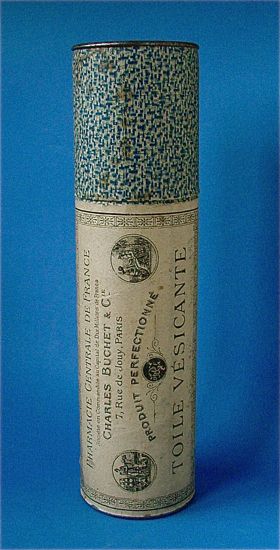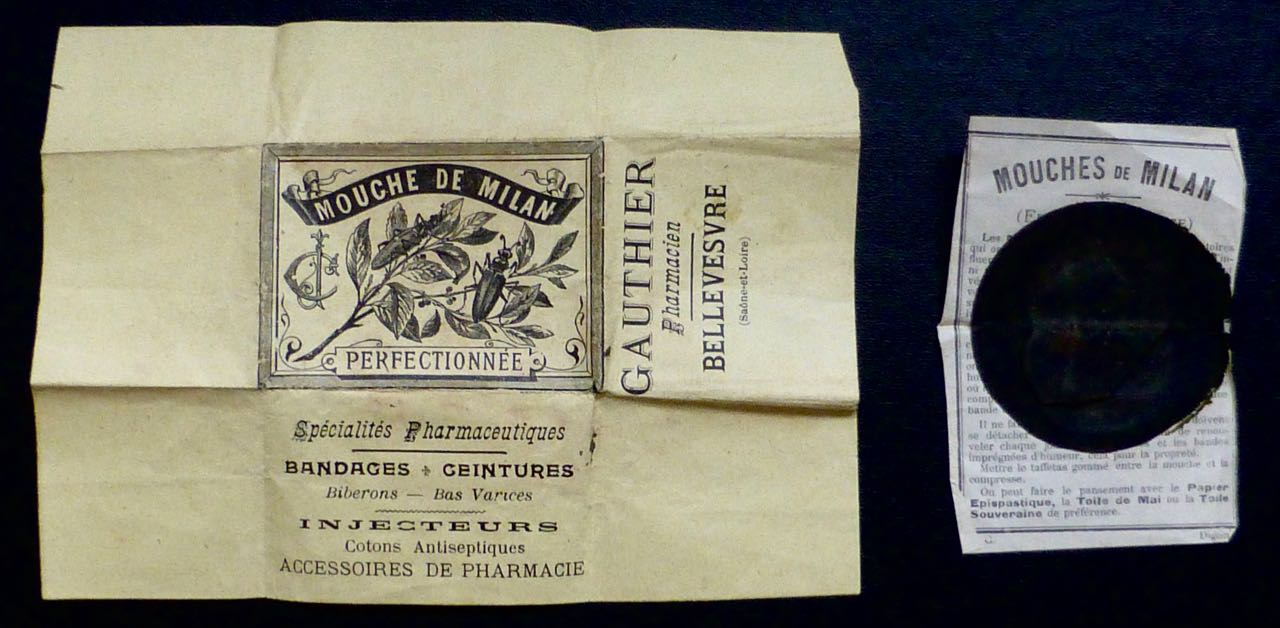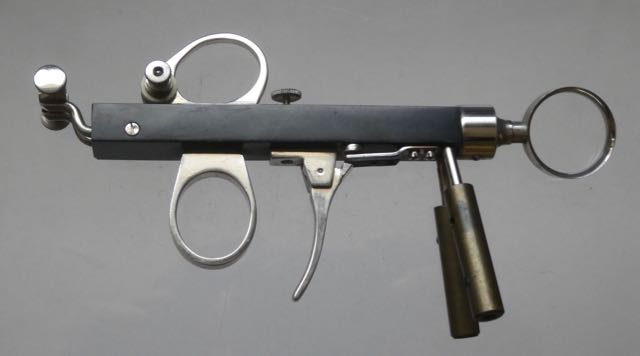Surgery |
||
Bleeding, white (2) |
||
In 1891 Luxembourg exported 62 kg of Spanish flies (!) (Memorial n ° 71 of 30.12.1892). Where these critters came from is, however, a mystery to me.
|
Surgery |
||
Bleeding, white (Mouches de Milan) |
||
"The fly is actually a winged beetle with a greenish-metallic color, and its potency-enhancing effects have long been known." In antiquity, the beetles were crushed into a powder that was taken or mixed into a meal by a man Emperor Nero have mixed the drug into the food of the (then current) imperial family to be able to use the orgasms so ignited later against their participants.
|
Surgery |
||
Blood collector by UNGER |
||
We present an Ernst UNGER (1875-1938) blood collector,, as it was in usen our clinics from 1930 to 1950. The equipment comes from the lumber room of the building of the Luxembourg Red Cross, opened in 1936, now "Maternité Charlotte" in Luxembourg ...
- Ernst Unger, Unterschiede in der Ausscheidung der Gruppenmerkmale. Indikationen und Technik der Bluttransfusion. - Ernst Unger, Fehler und Gefahren bei der Bluttransfusion. Med. Welt 1933, Nr 17. |
Surgery |
||
Bowel suture |
||
Device for the bowel suturing done by De MARTEL and WOLFSON, about 1950 |
Surgery |
|||
Cautery (1) |
|||
One of the oldest problems of the surgeons is haemostasis. In diffuse bleeding, astringent plants (oak bark, strawberry root etc) or minerals (alum) were probably put on in the early phase. In heavy bleeding, the spurting vessel was compressed. Already 3000 BC The Egyptians knew the cautery ... Apart from such practical measures, the use of magic played a role until the 19th century: "A saying from the Bible is quietly spoken to and crosses the bleeding spot three times with the forefinger" (Georg Friedrich Most, Encyclopaedia of Folk Medicine, 1843 p. 90).
Lit.: Walter von Brunn: Zur Geschichte der Blutstillung, Die medizinische Welt 9 (1935), S. 107f. E. F. Heeger: Zur Geschichte der Blutstillung im Altertum und Mittelalter, Wiener klinische Wochenschrift (1910), S. 1006-1008 und 1079-1080. Michael Sachs, Geschichte der operativen Chirurgie, Bd. I: Historische Entwicklung chirurgischer Operationen, Kaden Verlag Heidelberg, 2000. Michael Schlathölter, Geschichte der Theorie und Praxis der Wundheilung und Wundbehandlung unter besonderer Berücksichtigung des 19. und 20. Jahrhunderts, Münster 2005 |
Surgery |
||
Cautery (2) |
||
More modern than the "Paquelin" were from the early 20th century on devices in which the platinum thread was electrically heated. Galvanocaustic was invented in Finland by Gustav Samuel CRUSELL (1818-1858) from Tammela and further developed to therapeutic maturity - in 1848 he founded the "Institute électrolytique" in St. Petersburg.
|
Chirurgie |
||
Cautery (3a) by PAQUELIN |
||
Formerly, firing or annealing iron heated in the flame was used, followed by PAQUELIN's (1836-1905) heather, in which a different shaped hollow body of platinum heated to annealing and then by blowing a mixture of air and petrol vapor, the the glowing platinum surface burned, was obtained glowing.
|
SURGERY |
||
Cautery (3b) by PAQUELIN |
||
Burners are generally devices for the destruction of body tissues by incandescent heat. This causes, applied to surfaces volatile, different degrees of burns, which were brought about in the elderly medicine for the derivation of inflammation by the moxa. However, the incandescent heat also caused rapid hemostasis through the formation of a stuck scab, safe destruction of malignant tumors or infected tissue, and allowed bloodless tissue to be cut bloodlessly. Therefore, bleeding sites of the nasal mucosa, the inner surface of the uterus (!) Burned by burners, wounded by poisonous snakes or wounded dogs wound burned, blood-rich tissues, especially in gynecological operations and liver and lung operations, with the burning apparatus. In 1876, the French physician Claude André PAQUELIN (1836-1905) published a thermo-cautery with a platinum tip internally filled with very finely dispersed platinum moor, which, after being heated once, glowed, and through a gas-air mixture (supplied by a blower) (or other flammable vapors) could be kept glowing. *The discovery of the catalytic effect of platinum moor goes back to the pharmacist Johann Wolfgang DÖBEREINER (1780-1849). In 1816 he had succeeded in the oxidation of alcohol to acetic acid with the help of platinum moor. A few years later, he succeeded in igniting an oxyhydrogen gas mixture under the influence of platinum sponge one of the most important discoveries of early catalytic chemistry. It led to the invention of Döbereinerschen platinum lighter, which became a coveted commercial object. Textbook by Paquelin, purchased in 2005 from a dealer in Juan-Les-Pins. |
Surgery |
||
Cautery (4) by SCHECH |
||
Philipp SCHECH (1845-1905) was a professor at the University of Munich and significantly involved in the development of the local ENT department.
He wrote - Die Galvanokaustik in der Laryngochirurgie. Ärztl. Intelligenz-blatt 24 (1877) 443-444 - Die Krankheiten des Kehlkopfes und der Luftröhre mit Einschluss der Laryngoskopie und local-therapeutischen Technik für praktische Aerzte, 1897. |
Surgery |
||
Cautery (5) electric |
||
This is what the handset looked like before there were EU directives ...
|
Surgery |
||
Cautery (6) electric |
||
Electrocauteries are indispensable for cutting and coagulating in modern OR.
|
Surgery |
||
Cautery (7), transformator |
||
The transformer presented here consists of two current transformers: Félix Maloine made surgical instruments around 1912 (Catalog d'Instruments de chirurgie 1912)
|















